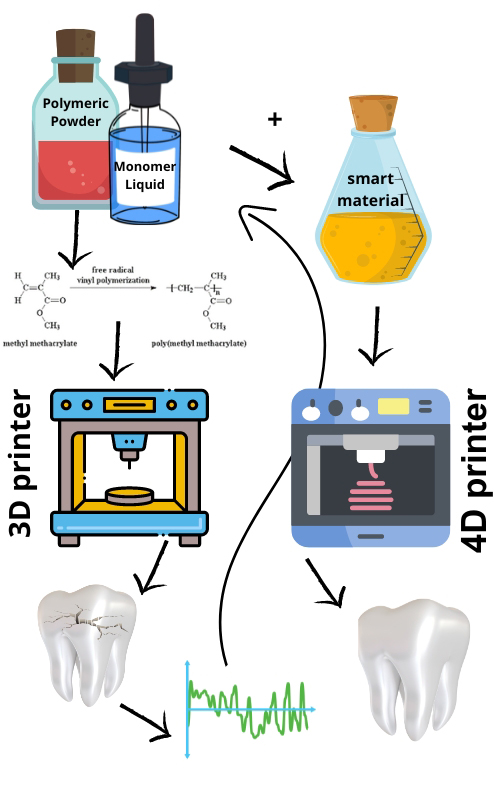Influence of the elasticity variation of the 3D printed PMMA structure on the axial tooth vibration Scientific paper
Main Article Content
Abstract
Recently, 3D printing with poly methyl methacrylate (PMMA) has been widely used in dentistry: 3D printing is a suitable method for producing any complex three-dimensional shape, and PMMA is a material that has suitable properties in the oral cavity environment. That is why 3D printing is very often used to make PMMA teeth. There is the impact between teeth during chewing that causes shape variation and tooth vibration. As cyclic vibrations adversely affect the durability of PMMA teeth, they must be eliminated. The object of this work is to study the axial vibrations of a 3D printed tooth, as well as to give recommendations for modifying the PMMA structure with the aim of vibration damping. Tooth vibration is mathematically modeled and analytically solved. The obtained result provides a link between the vibrational properties and the elasticity variation of the PMMA material. The function that defines the change in elasticity of PMMA depends on the “slow time”. (The term “slow time” implies a product of time and a parameter that is less than one). For a decreasing elasticity function, the vibration is of damped type: for higher is the elasticity reduction, the faster is the vibration decay. Based on the determined elasticity function, the modification of the PMMA structure can be realized. Authors propose the application of the obtained elasticity variation function for programming 4D printing with modified PMMA.
Downloads
Metrics
Article Details

This work is licensed under a Creative Commons Attribution 4.0 International License.

Authors retain copyright and grant the journal right of first publication with the work simultaneously licensed under a Creative Commons Attribution license 4.0 that allows others to share the work with an acknowledgement of the work's authorship and initial publication in this journal.
References
T. K. Vaidyanathan, J. Vaidyanathan, D. Arghavani, Acta Biomater. Odontol. Scand. 2 (2016) 108 (http://dx.doi.org/10.1080/23337931.2016.1219664)
G. Oberoi, S. Nitsch, M. Edelmayer, K. Janjic, A. S. Müller, H. Agis, Front. Bioeng. Biotechnol. 6 (2018) 172 (http://dx.doi.org/10.3389/fbioe.2018.00172)
H. Cai, X. Xu, X. Lu, M. Zhao, Q. Jia, H.-B., Jiang, J.-S. Kwon, Polymers 15 (2023) 2405 (https://doi.org/10.3390/polym15102405)
L. Peñate, J. Basilio, M. Roig, M. Mercadé, J. Prosthet. Dent. 114 (2015) 248 (https://doi.org/10.1016/j.prosdent.2014.12.023)
A. Nulty, Clin. Dent. 2 (2022) 44 (http://doi.org/10.20944/preprints202105.0316.v1)
M. S. Zafar, Polymers 12 (2020) 2299 (http://dx.doi.org/10.3390/polym12102299
R. Q. Frazer, R. T. Byron, P. B. Osborne, K. P. West, J. Long-Term Eff. Med. Implant 15 (2005) 629 (http://doi.org/10.1615/jlongtermeffmedimplants.v15.i6.60)
S. M. Pituru, M. Greabu. A. Totan, M. Imre, M. Pantea, T. Spinu, A. M. C. Tancu, N. O. Popoviciu, I.-I. Stanescu, E. Ionescu, Materials 13 (2020) 2894 (http://dx.doi.org/10.3390/ma13132894)
S. Jain, M. E. Sayed, M. Shetty, S. M. Alqahtani, M. H. D. Al Wadei, S. G. Gupta, A. A. A. Othman, A. H. Alshehri, H. Alqarni, A. H.; Mobarki, Polymers 14 (2022) 2691 (https://doi.org/10.3390/polym14132691)
G. Alp, S. Murat, B. Yilmaz, J. Prosthodont. 28 (2018) e491 (http://doi.org/10.1111/jopr.12755)
M. Petras, O. Naka, S. Doukoudakis, A. Pissiotis, J Esthet Restor Dent 24 (2012) 26 (http://doi:10.1111/j.1708-8240.2011.00467.x)
C. Polzin, S. Spath, H. Seitz, Rapid Prototyp. J. 19 (2013) 37 (http://dx.doi.org/10.1108/13552541311292718)
P. Protopapa, E. Kontonasaki, D. Bikiaris, K. M. Paraskevopoulos, P. Koidis, Dent. Mater. J. 30 (2011) 222 (http://dx.doi.org/10.4012/dmj.2010-135)
K. Afaf, B. Serier, K. Kaddouri, M. Belhouari, Fratt. Ed. Integrità Strutt. 53 (2020) 66 (http://dx.doi.org/10.3221/IGF-ESIS.53.06)
M. Wieckiewicz, V. Opitz, G. Richter, K. W. Boening, Biomed Res. Int. 2014 (2014) 150298 (http://dx.doi.org/10.1155/2014/150298)
H. Hamza, Innovation 1 (2018) e17 (http://dx.doi.org/10.30771/2018.4)
M. Javaid, A. Haleem, R. P. Singh, S. Rab, R. Suman, L. Kumar, J. Oral Biol. Craniofac. Res. 12 (2022) 388 (https://doi.org/10.1016/j.jobcr.2022.05.002)
L. Cveticanin, Strong Nonlinear Oscillators – Analytical Solutions, Mathematical Engineering, 2nd ed., Springer, Berlin, 2018 (ISBN 978-3-319-58825-4)
M. Farooq, E. Sazonov, Electronics (Basel) 5 (2016) (https://doi.org.10.3390/electronics5040062).





